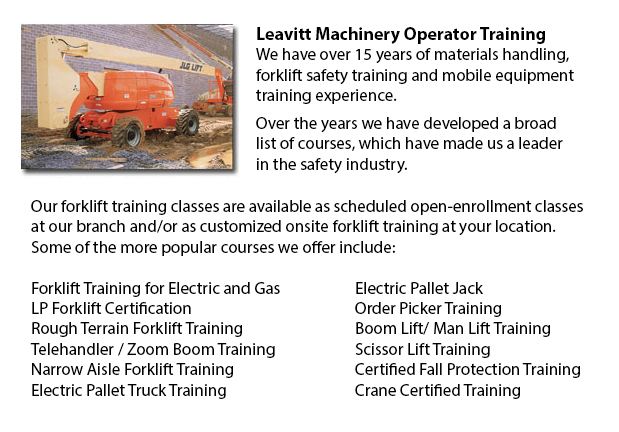
Oshawa Aerial Lift Certification - Aerial Lift Certification is for personnel who need a thorough knowledge of aerial lift safety. Construction craftsmen, supervisors and maintenance workers need this training to make sure that inspectors and operators are qualified. Provincial, state and federal regulations need businesses to be certified to be able to perform in-house aerial lift checks.
Nearly all workers who are needed to perform tasks at elevated level will often make use of the same means to get to these required heights, regardless of the type of work that should be carried out. Aerial lifts and scissor lifts are the mechanized devices made use of to lift equipment and employees to elevated places.
Bucket trucks referred to as Cherry Pickers are aerial platforms which feature a bucket and supported boom. The main danger to using this particular kind of platform is often tip-overs, falls and electrocutions. Certification makes certain that workers who utilize aerial lifts are trained properly in order to work the equipment safely. Training likewise ensures that workers know how to maintain aerial work platforms based on the manufacturer's directions.
Aerial lift training certification programs will comprise the following: Aerial lifts that are mounted to vehicles, Boom-supported scissor lifts and aerial lifts. Trainees will know about safe operating procedures and will gain knowledge about the hazards that often lead to aerial lift incidents. They would be technically competent in the various types of aerial lifts, as well as terminology and parts. From choosing the best aerial lift for the task to interpreting rated capacity charts, the certification program will provide employees with everything they must know in order to safely perform their work.
Individuals who are assigned the job of checking aerial lift machines need to know how to check gears, booms, operating mechanisms, structural parts, control systems and functions, braking systems, power plants, attachments, shafts and pins, electric and pneumatic parts, hydraulic, operator aids and emergency safety devices, et cetera. Training would include the following: the inspector's role in reducing liability exposure and accidents; monthly and annual inspection; how to perform a pre-use; how to write inspection reports; how to apply and interpret rules regarding aerial lift safety standards; inspection procedures, techniques and checklists; following record keeping requirements; applying and understanding the three levels of aerial lift inspection; and when to remove aerial lifts from service when they are defective.
-
Oshawa Scissor Lift Operator Certification
Oshawa Scissor Lift Operator Certification - North American regulators recommend that worksites need operators of scissor lifts, booms or aerial work platforms to obtain certification training. Scissor lift operator certification is not mandatory, bu... More -
Narrow Aisle Forklift / Order Picker Training / Electric Pallet Jack / Electric Pallet Truck Training in Oshawa
A pallet lift is a model of equipment dedicated in the moving of pallets of many dimensions and weights. They might be utilized as an appendage for platform lifts, cranes and other types of heavy machinery or be applied on their own. Pallet hoists ar... More -
Oshawa Crane Operator Certification
Oshawa Crane Operator Certification - The process to permit people to be able to operate certain kinds of cranes is to take crane operator certification training to get certification. The certification process incorporates classroom learning, hands-o... More -
Oshawa Aerial Platform Training
Oshawa Aerial Platform Training - Aerial platform lifts might be utilized to accomplish a lot of unique tasks executed in hard to reach aerial places. A few of the odd jobs associated with this style of lift include performing routine repair on build... More -
Oshawa Forklift Certification Schools
Oshawa Forklift Certification Schools - Forklift Certification is mandatory within North America. Hence, forklift training programs are important both for companies and for people seeking jobs in industries as forklift operators. Forklift training fo... More -
Oshawa Heavy Equipment Ticket
Oshawa Heavy Equipment Ticket - Depending on the nature of the job at hand, the type of construction equipment that a heavy equipment operator makes use of varies. Each and every type of machine is built to perform specific jobs in the most effective... More -
Oshawa Heavy Equipment Certification
Oshawa Heavy Equipment Certification - Large pieces of machines and heavy-duty vehicles are usually known as heavy equipment. This broad term includes utility vehicles from forestry and agricultural implements to civil engineering vehicles, construct... More -
Oshawa Overhead Crane Safety Training
Oshawa Overhead Crane Safety Training - The overhead crane safety training program is meant to equip the operators with the right skills and knowledge in the areas of: crane safety precautions, accident avoidance, materials handling, and equipment an... More

Forklift Certification Oshawa
TOLL FREE: 1-888-254-6157
Oshawa, Ontario
forkliftcertificationoshawa.com
Email Us
About Us


